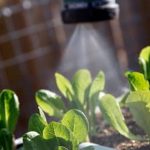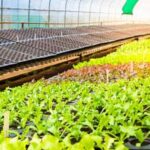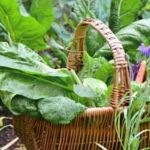Small yard fruit and vegetable gardening is a fantastic way to make the most of limited outdoor space while enjoying the benefits of homegrown produce. Whether you have a small backyard, balcony, or even just a patio, you can still grow a variety of fruits and vegetables with the right techniques and strategies.
In this article, we will explore the beauty and benefits of small yard fruit and vegetable gardening, as well as provide practical tips for maximizing your space and creating a successful garden.
Many people may think that having a small yard means they cannot enjoy the pleasures of gardening or growing their own fruits and vegetables. However, with some creativity and planning, it’s entirely possible to cultivate a thriving garden in even the smallest of spaces. From freshly picked strawberries to flavorful tomatoes, there is nothing quite like harvesting your own produce from your own backyard or balcony.
Throughout this article, we will discuss how to assess your space effectively, choose the right fruits and vegetables for small yards, utilize container gardening and vertical gardening techniques, and provide essential tips for watering, fertilizing, pest control, harvesting, and enjoying the fruits of your labor. Additionally, we will share inspirational success stories from individuals who have embraced small yard gardening with incredible results.
Whether you are new to gardening or looking to optimize your limited outdoor space, this article will provide valuable insights and guidance for making the most of small yard fruit and vegetable gardening.
Assessing Your Space
Having a small yard doesn’t mean you can’t enjoy the benefits of a bountiful fruit and vegetable garden. In fact, with some careful planning and creative solutions, even the tiniest outdoor space can be transformed into a thriving garden. Assessing your space is the first step in making the most of your limited garden space.
To make the most of your small yard for fruit and vegetable gardening, start by taking stock of the available space. Consider any existing landscaping or structures that may impact your garden layout, such as trees, shrubs, or patio areas. Take note of areas that receive ample sunlight as well as any shaded spots that could be utilized for plants that thrive in less light.
Once you have assessed your space, it’s time to get creative with your garden design. Consider incorporating vertical elements such as trellises or hanging planters to maximize space. Utilize containers and raised beds to make the most of limited ground space. With strategic planning and thoughtful consideration of your available space, you can create a productive and beautiful small yard fruit and vegetable garden.
Incorporate these ideas into your small yard fruit and vegetable gardening plan:
- Use vertical gardening techniques such as trellises and wall-mounted planters to maximize growing space.
- Utilize raised beds and containers to make the most of limited ground space.
- Consider planting dwarf or compact varieties of fruits and vegetables that are well-suited for small yards.
- Incorporate edible landscaping by integrating fruit-bearing trees and shrubs into existing flower beds.
- Optimize sunlight exposure by strategically placing plants in sunny spots while also making use of shaded areas for shade-loving crops.
Choosing the Right Fruits and Vegetables
When it comes to small yard fruit and vegetable gardening, choosing the right varieties of plants is essential to make the most of limited space. While it may be tempting to try to grow a wide variety of fruits and vegetables, it’s important for gardeners with small yards to focus on plants that are well-suited for smaller spaces and can thrive in containers or when grown vertically.
For fruits, consider planting compact varieties like dwarf apple or peach trees, as well as berries such as strawberries and blueberries, which can be grown in hanging baskets or vertical planters. These smaller-sized fruit plants not only fit well in tight spaces but also tend to bear fruit earlier than traditional-sized trees.
In terms of vegetables, opt for smaller varieties that are specially bred for container gardening. Compact options such as bush tomatoes, baby carrots, mini bell peppers, and dwarf eggplants are all excellent choices for small yard gardens.
Additionally, herbs like basil, thyme, and parsley are perfect for growing in pots or window boxes and can easily add fresh flavors to your meals. By selecting the right kinds of fruits and vegetables for your small yard garden, you can maximize your harvest while enjoying the beauty and benefits of homegrown produce.
| Fruit Variety | Vegetable Variety |
|---|---|
| Dwarf Apple Trees | Bush Tomatoes |
| Dwarf Peach Trees | Baby Carrots |
| Strawberries (in hanging baskets) | Mini Bell Peppers |
| Blueberries (in vertical planters) |
Container Gardening
When it comes to choosing the right pots and planters for small yard fruit and vegetable gardening, consider the following options:
- Terra cotta pots: These classic pots are perfect for growing herbs, cherry tomatoes, peppers, and small salad greens.
- Hanging baskets: Ideal for strawberries, trailing tomatoes, lettuce, and herbs.
- Window boxes: Great for growing shallow-rooted crops like radishes, green onions, or compact varieties of lettuce.
- Vertical wall planters: Perfect for maximizing space by growing herbs or leafy greens on a vertical surface.
In addition to choosing the right containers, it’s important to select the appropriate soil mix for your small yard gardening needs. Look for a high-quality potting mix that provides good drainage and retains moisture. Consider adding compost or organic fertilizer to provide essential nutrients for your plants.
Finally, don’t forget about regular maintenance for your container garden. Water your plants according to their specific needs (some may require daily watering in hot weather), fertilize as needed, and keep an eye out for pests that may target your fruits and vegetables.
With the right approach to container gardening in a small yard space, you can enjoy a bountiful harvest of homegrown produce while making the most of limited outdoor space. Whether you’re using pots on a patio or window boxes on a balcony, there are plenty of opportunities to grow delicious fruits and vegetables even with limited area.
Vertical Gardening
When it comes to small yard fruit and vegetable gardening, maximizing space is crucial. One innovative way to make the most of limited garden space is through vertical gardening. This method involves growing fruits and vegetables upward instead of outward, utilizing walls, trellises, and other structures to support plants and encourage them to grow vertically.
One advantage of vertical gardening is that it allows for greater variety in a small space. By using trellises or stakes, vining plants like tomatoes, cucumbers, and peas can be trained to grow upward, saving valuable ground space for other crops. Additionally, vertical gardening can help improve air circulation and sunlight exposure for plants, leading to healthier growth and potentially higher yields.
For those with small yards or even just a balcony or patio, vertical gardening offers an opportunity to cultivate a wide range of fruits and vegetables without requiring a large amount of square footage. Whether it’s installing a simple trellis for climbing beans or creating an elaborate vertical garden system with multiple tiers, this approach is a practical and visually appealing way to maximize growing potential in limited spaces.
| Vertical Gardening Benefits | Example Fruits/Vegetables |
|---|---|
| Maximizes space | Tomatoes, Cucumbers, Peas |
| Improves air circulation | Beans |
| Greater variety in limited area | Lettuce, Herbs |
Tips for Successful Small Yard Gardening
Small Yard Fruit and Vegetable Gardening requires special attention to watering, fertilizing, and pest control in order to ensure a successful harvest. With limited space, every plant counts, so it’s important to make the most of your garden by keeping your plants healthy and protected from harmful insects. Here are some tips to help you maintain a thriving small yard garden.
Firstly, when it comes to watering, it’s crucial to find the right balance. Over-watering can lead to root rot, while under-watering can result in stunted growth and poor fruit production. The key is to water deeply but infrequently, allowing the soil to dry out slightly between waterings. Consider using a drip irrigation system or soaker hoses to deliver water directly to the roots of your plants, maximizing efficiency and reducing water waste.
In terms of fertilizing, small yard fruit and vegetable gardening requires regular feeding as many crops are grown in containers with limited access to nutrients in the ground. Choose a high-quality organic fertilizer that is specially formulated for fruits and vegetables, and follow the instructions on the package for best results. Additionally, consider adding compost or worm castings to enrich the soil and provide essential nutrients for your plants.
Lastly, pest control is an important aspect of small yard gardening. Pests such as aphids, caterpillars, and mites can wreak havoc on your plants if left unchecked. Consider using natural remedies such as neem oil or insecticidal soaps to prevent infestations without harming beneficial insects like bees and butterflies. Regularly inspect your plants for signs of pests or disease, and take action promptly to protect your precious crops.
By paying close attention to watering, fertilizing, and pest control, you can ensure a successful small yard fruit and vegetable gardening experience while enjoying a bountiful harvest of fresh produce from your own backyard.
Harvesting and Enjoying the Fruits of Your Labor
Preserving Your Harvest
Once your small yard fruit and vegetable gardening efforts have paid off, it’s important to make the most of your bountiful harvest. One way to do this is by preserving the extra produce for later use. Canning, freezing, and pickling are all popular methods of preserving fruits and vegetables. By doing so, you can enjoy the tastes of your garden all year round.
Sharing With Others
Another way to enjoy the fruits of your labor is by sharing your harvest with friends, family, and neighbors. Not only does this strengthen community bonds, but it also allows others to experience the joy of homegrown produce. Additionally, if you have an excess of fruits and vegetables, consider donating them to local food banks or shelters to help those in need.
Celebrating Your Success
Harvest time is a cause for celebration in any garden, especially a small yard fruit and vegetable garden. Consider hosting a gathering with loved ones where you can showcase your hard work and share delicious dishes made from your own crops. This not only gives you an opportunity to savor the flavors of your harvest but also allows you to inspire others to start their own small yard gardening journey.
Inspirational Small Yard Gardening Success Stories
When it comes to small yard fruit and vegetable gardening, there are numerous success stories that can inspire and encourage others to embark on their own gardening journey. These real-life examples serve as testaments to the fact that limited garden space should not hinder anyone from enjoying the benefits of growing their own produce.
Overcoming Space Limitations
One inspiring success story comes from a couple living in an urban apartment with only a small balcony. Despite having minimal space, they were able to transform their balcony into a thriving garden filled with herbs, tomatoes, and strawberries. Their innovative use of vertical gardening techniques and hanging planters allowed them to make the most out of their limited space, proving that even those in urban environments can enjoy the rewards of homegrown fruits and vegetables.
Community Garden Triumphs
In another heartwarming success story, a group of neighbors in a densely populated urban area came together to create a community garden in a vacant lot. With everyone contributing their time and resources, they were able to cultivate a beautiful garden filled with an array of fruits and vegetables.
Through collaboration and dedication, they turned a neglected piece of land into a vibrant green oasis that not only provided them with fresh produce but also strengthened the bonds within their community.
Adaptive Gardening Techniques
Lastly, there is the story of an individual with physical limitations who was determined to pursue their passion for gardening despite having a small yard. By employing adaptive gardening techniques such as raised beds and compact varieties of fruits and vegetables, they were able to create an accessible and productive garden that catered to their needs.
Their perseverance serves as an inspiration for others facing similar challenges, showing that with creativity and determination, anyone can enjoy the rewards of small yard fruit and vegetable gardening.
Final Thoughts
In conclusion, small yard fruit and vegetable gardening offers a plethora of benefits for those who are limited in garden space. Whether you have a tiny backyard, a balcony, or even just a few windowsills, there are numerous ways to grow your own fresh produce and enjoy the satisfaction of harvesting and enjoying your own fruits and vegetables.
By utilizing container gardening and vertical gardening techniques, it is possible to maximize the space available to you. With careful planning and thoughtful selection of the right varieties for small yards, anyone can create a thriving garden that yields a bountiful harvest. Additionally, practicing proper watering, fertilizing, and pest control techniques will help ensure the success of your small yard fruit and vegetable garden.
Furthermore, as evidenced by real-life success stories in small yard gardening, there is immense satisfaction and joy to be found in this endeavor. The ability to tend to your own plants, watch them grow, and ultimately harvest the delicious fruits of your labor is truly rewarding.
Embracing the joys of small yard fruit and vegetable gardening allows individuals to connect with nature, improve their well-being, and contribute positively to their environment – all from the comfort of their own limited outdoor space.
Frequently Asked Questions
What Vegetable Gardens Grow in Small Spaces?
Many vegetables can thrive in small spaces, including tomatoes, peppers, lettuce, radishes, and herbs like basil and cilantro. These can be grown in containers or raised beds to maximize space.
How Do You Grow Vegetables in a Small Backyard?
Growing vegetables in a small backyard requires thoughtful planning. Utilizing vertical gardening techniques, using compact varieties of plants, and interplanting different crops can help make the most of limited space while still yielding a fruitful harvest.
How Do You Layout a Small Vegetable Garden?
When laying out a small vegetable garden, it’s essential to consider factors such as sunlight exposure, water accessibility, and plant compatibility. Using square foot gardening or planting in wide rows can help optimize space and make maintenance easier. Additionally, grouping together plants with similar needs can also improve efficiency in caring for the garden.

If you’re looking to get into vegetable gardening, or are just looking for some tips on how to make your current garden better, then you’ve come to the right place! My name is Ethel and I have been gardening for years. In this blog, I’m going to share with you some of my best tips on how to create a successful vegetable garden.





